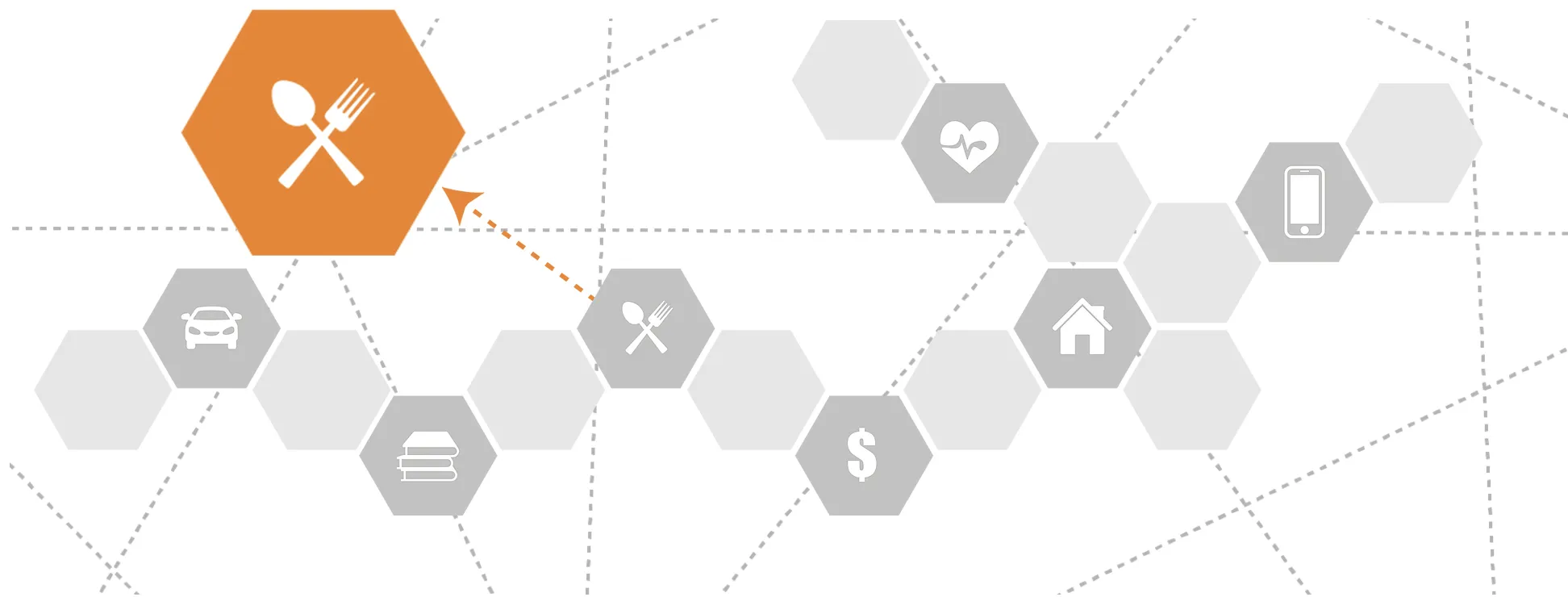
|
Housingclick to view |

|
Health Careclick to view |

|
Child Care and Educationclick to view |

|
Technologyclick to view |

|
Foodclick to view |

|
Taxesclick to view |

|
Transportationclick to view |
||
Future Trends Feeding ALICE
More young adults are using food pantries. Food pantries have been growing significantly as a resource for people under the age of 25, the group most likely to be ALICE or to live in poverty in all United For ALICE partner states. For example, reports consistently find higher rates of food insecurity among college students. In response, the number of university-affiliated food pantries rose from four in 2008 to 121 in 2014, and expansion continues across the country.39 Similarly, the number of member institutions in the College and University Food Bank Alliance has grown from 88 in 2012 to 686 in 2018.40
As the U.S. population ages, the number of food-insecure seniors (65 and over) is also increasing. Due to both increased financial hardship and the aging population, the number of food-insecure seniors more than doubled from 2001 to 2016, to 4.9 million. If this trend continues at the current rate, as it is expected to do, there will be more than 8 million food-insecure seniors by 2050. Seniors are more likely to experience food insecurity if they are unemployed, female, people of color, divorced or separated, or living with grandchildren.41
When seniors face food insecurity, the consequences can be more serious than they are for younger people, especially when it comes to health. Seniors who experience food insecurity are more likely than other seniors to experience chronic health conditions such as:
- Depression (78 percent more likely)
- Asthma (55 percent more likely)
- Chest pain (40 percent more likely)42
- Limitations in activity (21 percent more likely)
- High blood pressure (10 percent more likely)
Public benefits will not be sufficient to eliminate the need for emergency assistance. With changes in the economy, many low-wage workers — even those with public assistance benefits — are now forced to use food pantries on a regular basis. Six months of SNAP benefit use was associated with a 35 percent reduction in emergency food pantry use; however, 13 percent of SNAP recipients still use pantries six months after starting benefits, and more than half (59 percent) of persistent users — those who have relied on food pantries for more than two years — also participated in SNAP.43 Seniors, like low-wage workers, are often forced to use food pantries regularly despite receiving Social Security or disability benefits.44
Add to feelings of exclusion: Those experiencing food insecurity understandably report feeling excluded and powerless. Because those who have been historically underserved are more likely to face food insecurity, such as people of color, first-generation immigrants, and low-income students — the pain and embarrassment only adds to their feeling of exclusion. Especially in a country with great abundance, hunger deepens an equity divide and is not conducive to community cohesion.45
Sources
39
Bahrampour, T. (2015). More College Students Battle Hunger as Education and Living Costs Rise. Washington Post. Retrieved from https://www.washingtonpost.com/local/morecollege-students-battle-hunger-as-education-and-living-costsrise/2014/04/09/60208db6-bb63-11e3-9a05-c739f29ccb08_story.html?utm_term=.9a5ac9a5d19a
40
Goldrick-Rab, S., Cady, C., & Coca, V. (2018). Campus food pantries: Insights from a National Survey. The Hope Center. Retrieved from https://hope4college.com/wp-content/uploads/2018/09/2018-CUFBA-Report-web-2.pdf
Diamond, K. K., & Stebleton, M. J. (2017, April 11). “Do you understand what it means to be hungry?” Food insecurity on campus and the role of higher education professionals. The Mentor: An Academic Advising Journal. Penn State, Division of Undergraduate Studies. Retrieved from https://dus.psu.edu/mentor/2017/04/do-you-understand-what-it-means-to-be-hungry-food-insecurity-on-campus-and-the-role-of-higher-education-professionals/
Hamelin, A.-M., Habicht, J.-P., & Beaudry, M. (1999, February). Food insecurity: Consequences for the household and broader social implications. The Journal of Nutrition, 129(2), 525S–528S. Retrieved from https://academic.oup.com/jn/article/129/2/525S/4731686
41
Ziliak, J. P., & Gunderson, C. (2018). State of senior hunger. Feeding America. Retrieved from https://www.feedingamerica.org/sites/default/files/research/senior-hunger-research/state-of-senior-hunger-2016.pdf
42
Ziliak, J. P., & Gunderson, C. (2018). State of senior hunger. Feeding America. Retrieved from https://www.feedingamerica.org/sites/default/files/research/senior-hunger-research/state-of-senior-hunger-2016.pdf
43
Feeding America. (2014). Hunger in America 2014: National report. Retrieved from http://help.feedingamerica.org/HungerInAmerica/hunger-in-america-2014-full-report.pdf
Worthington, J., & Mabli, J. (2017). Emergency food pantry use among SNAP households with children. Mathematica Policy Research. Retrieved from https://www.mathematica-mpr.com/our-publications-and-findings/publications/emergency-food-pantry-use-among-snap-households-with-children
44
Kaiser, M., & Cafer, A. M. (2016, June). Exploring long-term food pantry use: Differences between persistent and prolonged typologies of use. Journal of Hunger & Environmental Nutrition. Retrieved from https://www.researchgate.net/publication/304340038_Exploring_Long-term_Food_Pantry_Use_Differences_Between_Persistent_and_Prolonged_Typologies_of_Use
45
Hamelin, A.-M., Habicht, J.-P., & Beaudry, M. (1999, February). Food insecurity: Consequences for the household and broader social implications. The Journal of Nutrition, 129(2), 525S–528S. Retrieved from https://academic.oup.com/jn/article/129/2/525S/4731686
Diamond, K. K., & Stebleton, M. J. (2017, April 11). “Do you understand what it means to be hungry?” Food insecurity on campus and the role of higher education professionals. The Mentor: An Academic Advising Journal. Penn State, Division of Undergraduate Studies. Retrieved from https://dus.psu.edu/mentor/2017/04/do-you-understand-what-it-means-to-be-hungry-food-insecurity-on-campus-and-the-role-of-higher-education-professionals/

